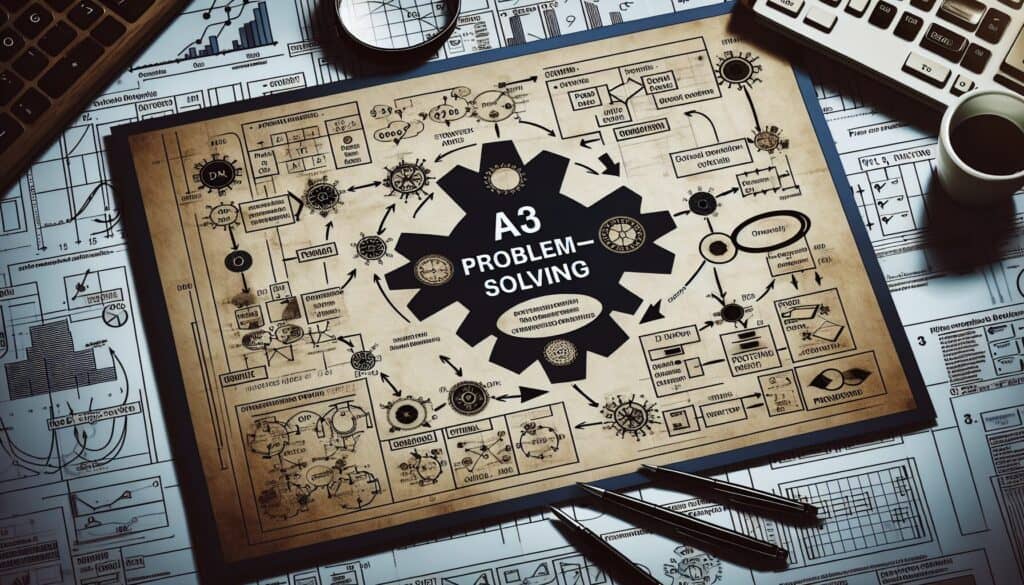Une approche structurée de résolution de problèmes et d'amélioration continue, généralement documentée sur une seule feuille de papier de format A3, qui suit un processus de réflexion logique., donc "Réflexion A3“ (souvent aligné sur le PDCA).
- Méthodologies : Lean Sigma, Fabrication
Réflexion A3

Réflexion A3
- Amélioration continue, Production allégée, Planifier, faire, vérifier, agir (PDCA), Techniques de résolution de problèmes, Amélioration des processus, Contrôle de qualité, Gestion de la qualité, Analyse des causes profondes, Travail d'équipe
Objectif :
Comment il est utilisé :
- Le rapport A3 comprend généralement les sections suivantes : Contexte/énoncé du problème, situation actuelle, objectif/cible, analyse des causes profondes, contre-mesures proposées, plan de mise en œuvre, suivi/résultats et normalisation. C'est un outil de collaboration.
Avantages
- Il favorise une communication claire et concise des problèmes et des solutions ; il encourage la réflexion systématique et l'analyse des données ; il facilite la collaboration et le partage des connaissances ; il sert d'outil puissant de coaching et de mentorat.
Inconvénients
- Il peut être difficile de condenser efficacement des problèmes complexes sur une seule feuille A3 ; cela nécessite des compétences en matière de facilitation et d'analyse des causes profondes ; cela peut être perçu comme un simple exercice de documentation si le processus de réflexion sous-jacent n'est pas intégré.
Catégories :
- Lean Sigma, Fabrication, Résolution de problèmes, Gestion de projet, Qualité
Idéal pour :
- Résoudre les problèmes de manière systématique, favoriser l'amélioration continue et encourager une culture de l'apprentissage et une communication claire, souvent dans un environnement Lean.
A3 Thinking finds its applications across various sectors including manufacturing, healthcare, and software development, particularly within organizations that prioritize Lean methodologies. For instance, in manufacturing, A3 reports can be utilized to tackle production inefficiencies by analyzing workflow bottlenecks and developing targeted solutions, while in healthcare, these reports can help streamline patient care processes by identifying root causes of delays in treatment. The methodology is most effective during the problem identification phase, where teams can collaboratively articulate issues and devise a common understanding before moving into solution development. Participants typically include cross-functional team members, project managers, and stakeholders who bring diverse perspectives to the table, which enhances collaboration and ensures that all aspects of a problem are addressed. The A3 report structure provides a clear framework that guides teams through systematic analysis and encourages the use of data-driven decision-making, which can lead to sustainable improvement initiatives. With ongoing follow-up and results tracking, organizations can establish standard practices that integrate lessons learned, promoting a continuous improvement culture that values learning and adaptability among team members. The clarity of communication inherent in A3 reports serves as a mentoring tool that allows less experienced team members to efficiently grasp problem-solving techniques from their peers, thereby building a stronger foundation for future projects.
Principales étapes de cette méthodologie
- Define the background and problem statement clearly.
- Analyze the current condition with relevant metrics.
- Set a specific goal or target condition to achieve.
- Conduct root cause analysis using appropriate techniques.
- Propose countermeasures based on the root causes identified.
- Develop a detailed implementation plan for the countermeasures.
- Establish a follow-up process to monitor results.
- Document lessons learned and standardize successful practices.
Conseils de pro
- Involve cross-functional teams early to enhance diverse perspectives in problem-solving.
- Utilize data visualization methods, like flowcharts or graphs, to clarify current conditions and root cause analysis.
- Establish clear metrics for success at the goal/target condition stage to measure impact effectively post-implementation.
Lire et comparer plusieurs méthodologies, nous recommandons le
> Référentiel méthodologique étendu <
ainsi que plus de 400 autres méthodologies.
Vos commentaires sur cette méthodologie ou des informations supplémentaires sont les bienvenus sur le site web de la Commission européenne. section des commentaires ci-dessous ↓ , ainsi que toute idée ou lien en rapport avec l'ingénierie.
Articles Similaires
Simulation de Monte Carlo
Tests basés sur des modèles
Contrôle des modèles
Recherche sur les méthodes mixtes
À l'épreuve des erreurs (Poka-Yoke)
Test du profil de la mission